mark@amazonrivermonsters.ca
429 Clearwater Lake Road, Port Sydney, Ontario P0B 1L0, Canada
Fish Species: Amazon Catfishing and Peacock Bass Fishing Trips/Tours in Brazil
Amazon Catfish, Arapaima's, Payara Vampire Fish, Peacock Bass, Piranhas Etc
Amazon Catfishing: Find the Best Fish Species in the World
Before taking you on an Amazon Catfishing trip Brazil, you must know about some of the top fish species found in the Amazon River.

The Mighty Piraiba
PIRAIBA (LAU LAU): The Piraiba, also known as the Lau or the Amazon’s “Freshwater Shark,” lives up to its fearsome nickname. This catfish boasts a tall, proud dorsal fin and is famous for its impressive size, reaching 400 lbs, making it the largest catfish in South America. Their immense size demands heavy-duty equipment: a strong rod, a large-capacity reel, and an expert guide to help you catch this fish. These giants are not shy about announcing their presence; hence, expect a fierce fight once they are hooked.

Jau Catfish
Nicknamed the “Sumo Wrestlers,” Jau catfish are as tough as their Piraiba and Redtail cousins. Native to the Amazon and Orinoco River basins, these brawlers can reach over 180 pounds in some rivers, with an average weight of around 30 pounds. This makes them a challenging game fish known for their size and strength. They are masters of using their environment to their advantage and once hooked, they make a powerful dash straight back to the nearest cave.
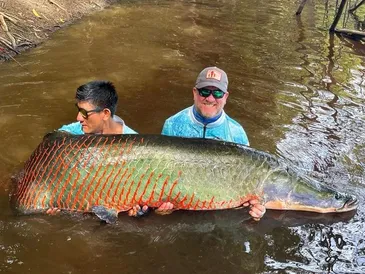
Arapaima Gigas (Pirarucu)
The Arapaima Gigas, ancient air-breathing giant fishes, are the native species of arapaima to the Amazon River Basin in South America. Known as one of the largest freshwater fishes in the world, it attains a length of up to 10ft (3m) and weighs up to 485 lbs(220kg). These fishes are significantly ecologically and culturally significant food sources for local communities in the Amazon region. You can identify them by their streamlined body with a dorsal fin stretching along its back, and it is mainly gray-green with red dots on the scales. They primarily feed on fish but are also known to consume fruits, seeds and insects.
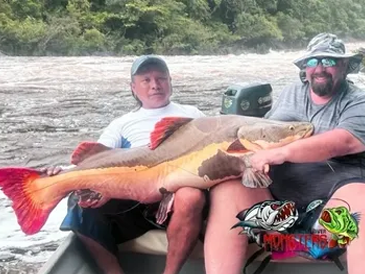
Red Tail Catfish
REDTAIL CATS: This catfish has a distinctive appearance, with a brownish back, yellow sides and orange-red dorsal and caudal fins. It has a broad head with long whiskers, can reach five feet (1.5m) or more long, and weighs up to 180 pounds (82kg). They stay motionless during the day, eat only during the day and night, and move slowly. Once caught, these fish battle like no other, racing to the closest log underneath, snag, rock, or anywhere they can get your hook stuck. They will make multiple long runs and quickly rip line from the spool throughout the fight. This makes Amazon Catfishing a great fun experience.
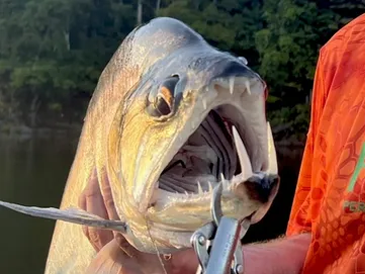
Payara / Vampire Fish
PAYARA / VAMPIRE FISH: The Payara, also known as the Vampire Fish, is a predatory fish known for its aggressive nature and striking physical features. There are two species of Payara: Silver Payara and orange/pink-tailed Payara. The silver ones are the largest and can grow over 35 pounds, while the pink ones are the rarest and smallest, reaching only 8-10 pounds. They move fast deep down the water and are the predators that wait for their prey. If you dream of catching a massive Payara, look no further than our Amazon fishing trips.
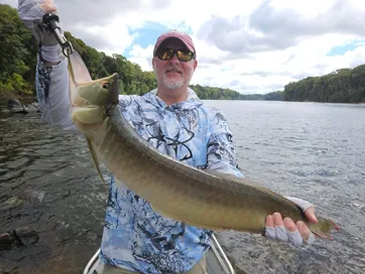
Arowana
AROWANA OR MONKEY FISH: The Arowana, also known as the Monkey Fish, can reach over 39 inches (100cm) in length and weigh up to 14 lbs. Their elongated, snake-like bodies are accentuated by a bony head, long dorsal fin, and heavy scales. This unique build even allows them to swim backward. Also, they are strategic hunters. They lurk under trees near riverbanks, then launch impressive jumps to snatch insects, frogs, or even birds from the water's surface. Their aggressive nature and remarkable size make catching one challenging but no less rewarding. Arowana's captivating appearance and unusual abilities make them prized subjects for aquarium enthusiasts and researchers.
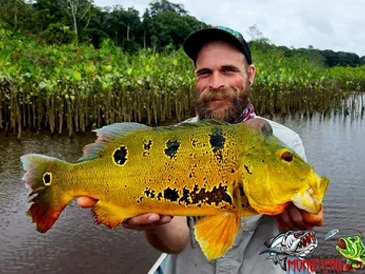
Peacock Bass
PEACOCK BASS: They are huge!! These butterfly peacock bass fish are members of the cichlid and tilapia families. They have a semi-elongate body, largemouth, and a deep notch between dorsal fins. At the Amazon River, you can find two species of Peacock Bass: the yellow one, which can reach up to 15 lbs and the smaller one, reaching up to 10 lbs. They are known for their aggressive strikes, often mistaken lures for prey or rivals. When hooked, they fought incredibly, leaping, running, and diving towards cover. Don’t miss out on booking your Amazon Peacock Bass fishing trip and experience the real fun of fishing.
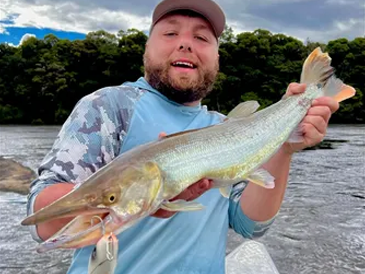
Bicuda (Boulengerella Cuvieri)
BICUDA OR SWORDFISH: Bicuda fish are found in the Amazon region, inhabiting various tributaries and freshwater environments. They are known for their aggressive nature and fast-start predatory behavior, making them prized adversaries for anglers in the Amazon basin. You can catch them on top-of-the-water spooks, poppers, shallow-diving minnows, and glide baits. However, due to their jawbone structure, they can be challenging to keep on the hook. Hence, if you wish to catch this fish, our hosts can help you as soon as possible.
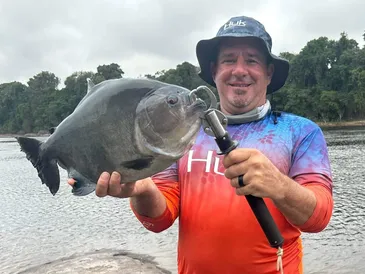
Black Piranha
BLACK PIRANHAS: The Black Piranha, the red-eyed demon of the Amazon, is the most aggressive fish in Essequibo. They can grow up to 41.5-61 centimeters (16.3-24 inches) in standard length, with an average length of around 32 centimeters (13 inches), and can weigh up to 3.0 kilograms (6.6 pounds). These fishes devour anything in their sight, and bite chunks out of any passing fish. They are attracted to the smell of blood and the frantic splashing of an injured animal. If you are trying to catch one, be prepared to change out lures, as their bite force (72 psi per pound) can be powerful.
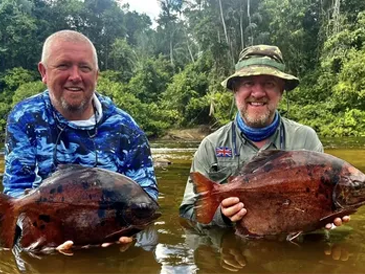
Pacu
RED PACU, SILVER PACU AND MOON DRILL PACU:
Pacu are a group of freshwater fish native to South America. They come in three main varieties: red, Silver, and Moon Drill. These impressive fish are known for their surprisingly human-like teeth and massive size—they can reach up to 3 feet and weigh around 65 pounds. They're also surprisingly strong fighters. Despite their fearsome appearance, Pacu are actually omnivores with a taste for nuts and fruits. Anglers can exploit this fondness. By hooking a small piece of fruit and repeatedly jigging it in the water, you can mimic a fruit falling from a tree and entice a Pacu to strike.
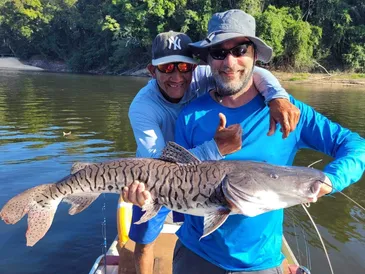
Surubim Catfish
SHOVEL–NOSED TIGER SURUBIM CATFISH: Surubim Catfish are famous for their remarkably adaptable nature. Their markings are beautiful, but don’t be fooled by their looks. They have haunted nearly all the waters of the rainforest. There is a reason they are called the fastest species of catfish in the river. White, their southern cousins, reach sizes exceeding 200 pounds. The Amazon and Orinoco basins and the Guyanas boast impressive populations reaching 50 pounds. So, if you have managed to hook a Surubin, be prepared for a fast and furious battle, as these fishes will test your skills and equipment. Get ready to test your Amazon Catfishing techniques.
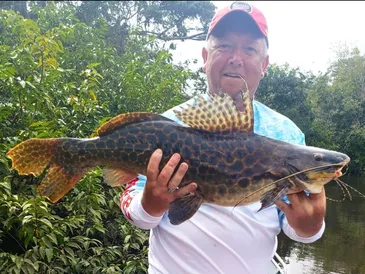
Leopard Catfish
LEOPARD CATFISH (Jundia): Scientifically known as Rhamdia Queen or Jundia, the Leopard Catfish is a Siluriform fish species characterized by its spotted appearance, which resembles a leopard. Pound for pound is the most potent catfish in the Amazon River. You can use fresh-cut bait like shrimp, fish, or chicken liver to catch these fish, as they can smell bait very well and are bottom feeders. Target areas like fallen trees, submerged logs or rocky ledges. Be patient and persistent, and keep your bait in the water to get some action.
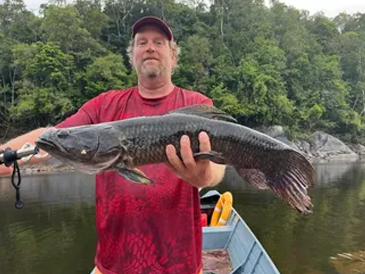
The Devil Wolfish
The Devil Wolfish or the Atlantic Catfish can be found in rivers, rapids, waterfalls and flooded forests in the South American continent. They are primarily stationary fish, rarely moving from their rocky homes. They are unique in appearance and contain four to six fang-like, strong conical teeth used to crush food items. Whenever anyone catches a wolfish, everyone gathers around to catch a glimpse of this prehistoric monster of the deep as they put up a vicious fight. So, if you also want to be one of them, get ready with your equipment and book your Amazon fishing trip.
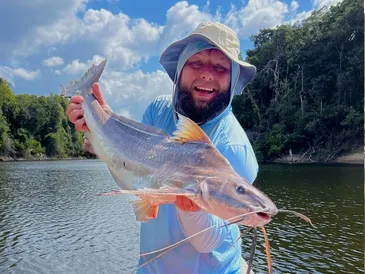
Long (Flat) Whisker Cat
Don't be fooled by their unusual appearance! The Flat-Whiskered Catfish (scientifically known as Pinirampus pirinampu) is a prized catch for anglers using lighter tackle. Found in the Amazon and Paraná River basins of South America, these impressive fish can reach over 35 pounds. Long, flat, ribbon-like whiskers twitch constantly on their faces as they navigate the deep waters or the open spaces they favor. While they may appear easygoing, Flat-Whiskered Catfish put up a thrilling fight when hooked. They can be lured in with small-cut bait, freshwater crabs, live fish, or even worms.
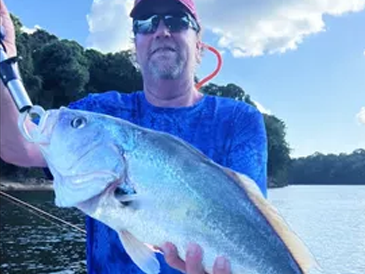
Pescada / Croaker
The Pescada, also known as the Freshwater Croaker or Hake, is a close relative of the American Redfish and other Saltwater Drums. These fish are a sight to behold with their bright, silvery bodies and blue-colored backs, weighing over 14 pounds. As we move on to discuss fishing techniques, it's essential to understand that the Pescada is an aggressive feeder that responds well to artificial lures and cut bait. That means you will need to use vibe lures, plastic shad on heavy jig heads, and casting deep-diving minnows. These lures are designed to mimic the fish's natural prey, making them effective for attracting aggressive feeders like the Pescada.
Enjoy Your Fishing And Catch Big Fish!.
Ready to reel in the big one? Join us for an unforgettable fishing experience and make your next catch legendary! Book now and let's hit the water together
Amazon River Fishing throughout the Amazon River Basin, Guyana, Suriname, Brazil, Colombia, Argentina, Bolivia and More.
Contact Us
429 Clearwater Lake Road, Port Sydney, Ontario P0B 1L0, Canada
Copyright © 2024 Amazon River Monsters - All Rights Reserved.
